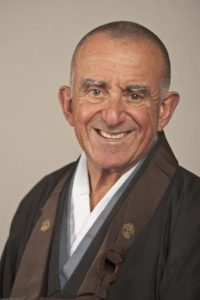Exploring Zen Kindness

The Abbot’s Letter
August 2022
“Exploring Zen Kindness”
“Crooked Cucumber,” David Chadwick’s 1990 classic biography of Suzuki-roshi, describes his history in Japan and the U.S., including early influences on his character. Known in his youth as Toshi, young Shunryu was born in 1904 into a Soto Zen family. His father was the priest at Shoganji, a temple east of Kobe.
Inspired by Buddhist teachings and practice at a young age, he had a clear vision of what he wanted to do with his life:
“I wanted to be an unusual priest who could tell people what Buddhism is and what the truth is . . . I determined to be a good priest.”
However, Toshi thought that his father was not strong enough to be his Zen teacher, would not be able to encourage the qualities he needed, even though the young boy felt great affection for him.
“My father took care of me too well . . . I always felt too much emotion, too much love.”
Although characterized as “weak,” his father’s kindness and support provided the foundation of love and acceptance that gave his son a stable and caring mind, ready to accept discipline and address difficulties with confidence. In “Crooked Cucumber,” Toshi describes Japanese people as tough, with a caveat:
“…but that is just one side of their personality. The other side is softness. Because of their Buddhist background they have been trained that way for a long time . . . without a soft mind you cannot be really strong.”
Young Shunryu was motivated by one of his school teachers who told him he should grow up to be a great man and urged him to be strong by “rising above sentimentality.” At age 11, he found the Zen teacher he needed in Gyokujūn So-On who was “tall, tough and exuded confidence.”
(The following story appeared in the December 2021 Abbots letter. It is worth repeating here.)
Toshi joined So-On and eight other young monks during a 100-day practice period. At work one day the boys and So-On were cleaning mud from the bottom of the temple pond. Toshi caught a goldfish that was carrying a tiny worm. He had seen this worm before in school so he held it up and proudly said,
“This is Mijinko!”
So-On immediately shouted: “SHUT UP,” forcefully admonishing his disciple not to call attention to himself. In recalling the incident years later, Suzuki-roshi said:
“To shout at me when I was personally showing off was another sort of mercy, another kindness.”
Outside of the Zen culture in Japan, So-On’s “SHUT-UP” seems critical and insensitive. Yet for Toshi, who was thirteen at the time, it was profound. He thrived on So-On’s strictness.
So-On did not have a clearly formalized way of teaching. He did not provide his students with specific instructions, remaining mostly silent about how to do things. Without guidance, the boys were expected to take care of their teacher’s needs in everyday activities around the temple and to assist him in conducting ceremonies. It was difficult for them to know what to do – when and how to bow, chant, and strike the bells – or to take care of tasks in the proper way. So-On scolded them when they did not get things “right,” pushing his students to pay attention, to maintain awareness, and to learn from the frustration of mistakes. It was his way of training them to respond spontaneously to situations, questions, and problems through the wisdom of experience, intuition and selflessness, rather than to rely on intellectual analysis or thinking things through.
To his students at San Francisco Zen Center, Suzuki-roshi gave no indication of having been trained by a strict and uncompromising teacher. His own manner, his way of being with people, was warm, patient and gentle. I heard of only two instances when he displayed anger toward his students.
Traditionally, discipline is administered by someone – parent, teacher, or boss – acknowledged as having the right to judge someone else based on legal, administrative, or moral authority. Loud, in-public admonishments such as “SHUT-UP,” may be effective for training of monks in Japan, but for the majority of Zen students in the west – with our culture of individualism and relatively comfortable life styles – a practice that includes personal criticism would be a major barrier.
Young Suzuki did not consider So-On’s discipline as criticism or punishment, but rather a gift of kindness. His attitude points to the comprehensive practice we should encourage, including both discipline and a commitment to community that emphasizes warm, caring relationships. But the discipline component must go beyond criticism from another. Rather, it should encourage Zen students to take responsibility for their own self-discipline,
Les Kaye
Abbot of Kannon Do


